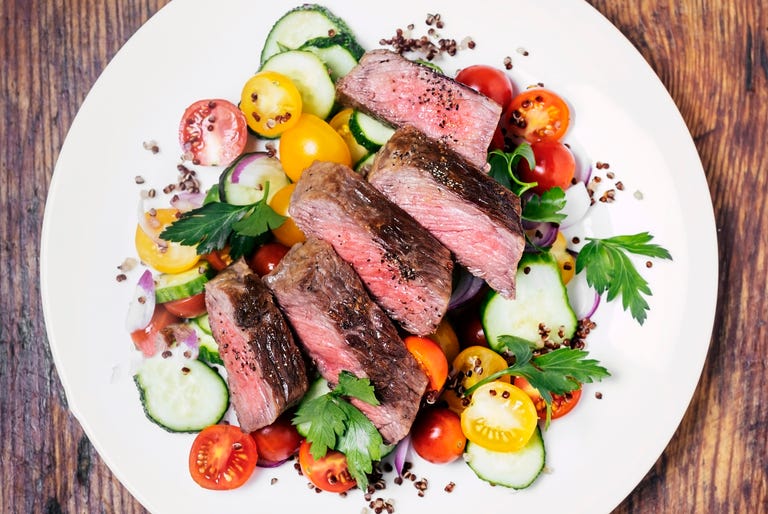WTF Is The Difference Between Keto And Paleo?


If ever there were rival diets, keto and paleo are it.
Both diets have blown up the Internet—and it doesn’t look like they’re going away anytime soon. And while you may think they’re practically synonymous (they are both low-carb, after all), their similarities end at cutting you off from bread.
“The main difference is that on the keto diet, most of your calories come from fat, whereas on the paleo diet, most of them come from protein,” explains dietician Keri Gans, RD, author of The Small Change Diet. Here’s what to know about all of the other differences, too, so you can decide whether either of the diets is worth trying on your own.
The keto diet
There’s no way you haven’t seen at least some keto content on the web recently…but even if you have, the diet can seem a little confusing, to say the least.
Basically, the keto diet is all about getting your body into a state called ketosis, where you’re burning fat for fuel instead of your body’s go-to energy source: carbs. To do this, you need to eat a whole lot of fat.
A post shared by Keto Diet (@ketomealsplan) on
“On the keto diet, you need to get 60 to 80 percent of your calories from fat, and the rest should basically come from protein,” says Gans. You can have a few carbs on the diet—but only about 10 percent of you daily calories (a big change from the current recommendations from The Dietary Guidelines for Americans, which suggests 45 to 65 percent of your daily cals from carbs).

And uh, if you think a high-fat allowance means a cheese free-for-all, think again—cheese has lactose, which is actually a carbohydrate (a.k.a. a keto diet no-go).
“Full-fat dairy is technically allowed, yes, but you can’t really have that much because you have to keep your carbs down,” says Gans. “It’s really more about eating full-fat foods like butter and olive oil that don’t have many other macronutrients that could mess up your ratio.”
Keto-friendly foods
The paleo diet
Compared to the keto diet, the paleo diet is a piece of cake (just, you know, not one you can eat). “The paleo diet is definitely more liberal than the keto diet, because you have more options, and you can have more fruits and vegetables,” says Gans.
Yumm yum @triplepeakpaleo ・・・ When the summer temperatures rise, I’m all about that salad life ?✌? . Here’s my simple, delicious, nutrient dense salad formula: 1️⃣ Greens: spanish, arugula, kale, mixed spring greens, or a combo! (avoid romaine or iceberg lettuce because they’re low in nutrients) 2️⃣ Veggies: 2-3 types, chopped (about 1/4 cup of each): cherry tomatoes, peppers, avocados, carrots, blueberries, etc. 3️⃣ Nuts (a handful): walnuts, almonds, pistachios, pine nuts, etc. 4️⃣ Protein (4oz): chicken, salmon, steak, a burger patty, shrimp, etc. 5️⃣ Dressing (1-2 tbsps): high quality olive oil (like @kasandrinos) mixed with a dash of balsamic vinegar or a scoop of pesto OR one of @primalkitchenfoods delicious dressings . This easy formula can be used to create hundreds of drool-worthy salads that will fill you up, dazzle your tastebuds, and because you’re not heating up any food, a salad like this will keep both your home and body cool in the hot temperatures!! . What are your favorite salad toppings?! . . #bigasssalad #salad #prettycolors #kevoo #kasandrinos #greekified #eattherainbow #nutrientdense #energyfood #jerf #foodisfuel #cleaneats #paleo #paleodiet #realfood #weightloss #paleoeats #whole30 #weightlossjourney #foodpics #whole30recipes #plantbased
A post shared by Kasandrinos Olive Oil (@kasandrinos) on
The paleo diet also doesn’t enforce super strict ratios like the keto diet; instead, it focuses on entire food groups to eat (like meats, fruits and veggies, and healthy fats) and avoid (like dairy, processed foods, and whole and refined grains). But it, too, has its drawbacks.
“Basically, it’s a way of eating that’s supposed to be similar to the way that our ancestors of the Paleo Age ate,” explains Gans. “That means staying away from processed/refined foods, legumes, grains, dairy…anything that cavemen couldn’t eat during the hunting and gathering times is not allowed.”
Paleo-friendly foods
So, which one should I try?
Look, both of them could help you lose weight in the short-term, but it’s quite possible that it’s because you are simply eliminating so many of your favorite foods—so you’re just not eating as much overall.
“Bottom line is that you could be losing weight because you’re basically restricting so much,” explains Gans. And when you do end up going off both diets, you could even end putting on more weight than when you started, she adds. Probably not ideal.

That said, if you had to choose one, paleo is probably the better choice. “It’s technically healthier, because you have more options, and the majority of your calories are not coming from full fat,” says Gans.
That means that the majority of your meals could technically be filled with lean meats and leafy greens, which is good—and could potentially be an upgrade from whatever you’re eating now.
An even better option: Focus on healthy foods that you can have, not ones you can’t. “At the end of the day, people should start focusing on what they should be eating, versus what they shouldn’t—and get back to actually enjoying their food,” says Gans.
Source: Read Full Article
